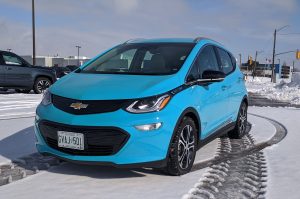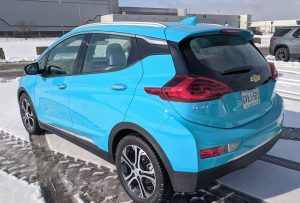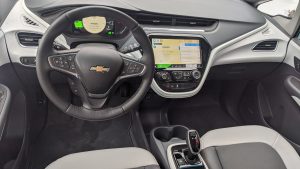2020 Chevrolet Bolt test drive
Posted by Rod Cleaver
The 2020 Chevrolet Bolt comes as a moderate upgrade over the earlier model first introduced in 2016. 

The biggest change comes at its core, the battery. By revising only the battery chemistry, without changing the battery size, engineers have added 34 kms of range, roughly 10% over
the original for a total theoretical range of 417 kms. That extra range matters as the Bolt’s claim to fame was the position it held as the highest range EV in the “affordable” category. In fact, even the base model Tesla Model 3 came with less range. As new models from Hyundai and Kia were introduced, the Bolt slipped and a revision was in order.
Other changes include a new high definition rear view and an available perimeter surround camera system as well as exterior paint colours. We were testing a eye popping Oasis Blue model, a tropical shade not
normally seen in northern sections of this continent. It did garner quite a bit of attention on the road, which I suppose most early adopters of EV vehicles don’t mind. Inside the cabin, the Bolt is a clean, almost spartan design. Almost all of the cabin controls are centred in a cluster high on the dash. Audio,
climate and vehicular configuration variables are all accessed here. Steering wheel mounted controls help to de-clutter the Bolt’s interior.
The Bolt has the exterior dimensions of a compact car but feels more Crossover with its spacious cabin and spacious hatchback cargo area with up to 1603 litres of storage.
The tall stance of the Bolt allows for a surplus of glass to encompass the occupants, as a result, the extra light and light interior make the cabin bright and cheery. For the most part sight-lines are great, the
only downside being extra thick pillars framing the windshield. These are required to provide structural integrity with the higher roofline. The obvious downside of the thick A-pillar is that it creates a significant blind-spot when scanning diagonal views on the roadway. The seats have manual adjustments which makes sense and are comfortable enough. Given the range and typical usage of the Bolt, I don’t imagine
While not Tesla’s insane mode, heading out in the Bolt comes with the iconic rush of acceleration typical of electric powertrains. Zero to 100kms/hr times out at 6.5 seconds. The ride in the Bolt is pretty firm but isolates harsh bumps on the road. The firm suspension rewards with a sporty yet pleasant ride, when combined with great acceleration, the Bolt is a fun to drive package.
Part of the allure of this and other EV’s is being on the leading edge of technology. Part of that early adopter status comes with some compromise and premium cost. But what it is like to live with an EV,
especially one with one of the best range capacities on the market?
Range, recharging, regeneration and power management all play a part in the EV experience. We picked up the 2020 Chevrolet Bolt at GM’s Engineering Centre in Oshawa, Ontario. The vehicle instrument cluster indicated it was fully charged, with a range indicated of 382 kms. The outside temperature at the time was just below the freezing mark, so heat was require and that affects your range. The 30 odd kilometre drive home was pretty much what the range indicator reflected. Upon reaching home I plugged in the Bolt
using the standard level one portable charger connected to an external outlet. As night approached I tested to make sure and realized the connector did not lock onto the vehicle so felt safer disconnecting till
morning. Upon checking the charge, six hours connected to an outlet had yielded 3 kilometres of extra range. This was worrying.
Next day off to the Metro convention Centre downtown. Nice perk of driving an EV was being able to use the high occupancy lanes while driving alone. As the drive towards the lake shore was downhill, range
depletion was only about half of the actual mileage travelled. The fact it was mostly congested highway driving helped with energy consumption.
Regeneration on the Bolt is quite effective with the addition of a steering a wheel paddle activating the re-generators in the brakes. Another option is a Low setting on the gear selector. This applies maximum regeneration through the wheels as soon as the accelerator pedal is lifted. It can best be compared to driving a golf cart. After a short time, feathering the accelerator to smooth out the ride was a breeze.
This could well be the industry standard for EV regeneration. Although I never used it, Chevy also has a feature on its My Chevrolet app that allows drivers to locate charging stations, plan trips using vehicle
Upon arriving at the Convention Centre parking lot, I located the only charging station in the south hall, a level two outlet. There is one on the north all also, making a total of 2 spots in the 1700 spaces
available. There is also a 3 hour limit for charging but its free. After a couple hours of charging I had replaced the 20 kilometres of range I had burned getting to the event. Returning home the drive up
from the lake consumed only slightly more range than mileage actually travelled. I was pleasantly surprised. The following day I was heading back to the Convention Centre parking lot for the Toronto Auto Show. I opted to delay recharging till I was back at the same parking lot rather than the feeble couple kilometres I could add with the portable charger. As I should have expected, the single charging station was occupied with one vehicle charging and another next to it, either waiting to charge or basking in the afterglow of the delivery of its electron load. So no charge today!
The Bolt was to be returned the following day and I still had about 150 kms of range by the time I returned home, so no big deal.
The day of return was a bit of an ordeal as overnight, temperatures had dropped to the mid minus twenties Celsius from the -6 when I had parked the vehicle. The Bolt’s batteries lost about 30kms of range with the
lows temps. Combined with the energy drain due to the need for heat, range anxiety kicked in. As I drove back to Oshawa on the highway, re-gen was not really a possibility and the battery drain accelerated. Half way there I was down to 86 kms of range and dropping. I elected to use the heat intermittently, to get back up close to 100 kms of range. When I arrived back in Oshawa, the Bolt still had about 70 odd kms on the range indicator. 

In all fairness, anyone buying an EV is going to choose to have a permanent charging station installed at their residence. The exception being if you live in an apartment or condominium where this may not be
practical or possible. With the ability to charge the vehicle properly overnight, I doubt range anxiety would be an issue.
If I have a choice between quality and price, I always choose quality. https://www.glowdentaldallas.com/dental-services/valium/ is perfect in this regard. It sells FDA-approved drugs of the highest quality. At the same time, the price policy of the online pharmacy is really democratic. There are brands and generics to buy, so anyone can choose the drug they feel comfortable with.
The Chevy Bolt comes in two trim levels, the base LT and upscale Premier that we were testing. The LT starts at $44,998 while the Premier lists at $50,298. For a breakdown on the trim differences visit the Chevrolet Canada website for specific details. Chevrolet is apparently introducing a revamped Bolt later this year and has just announced new technology batteries with better power capacities. These new batteries are expected to be installed in a small SUV based on the Bolt platform.
Copyright © Auto Reviews Online 2016 | Privacy & Terms of Use | info@autoreviewsonline.com | Website by Brolly Media


